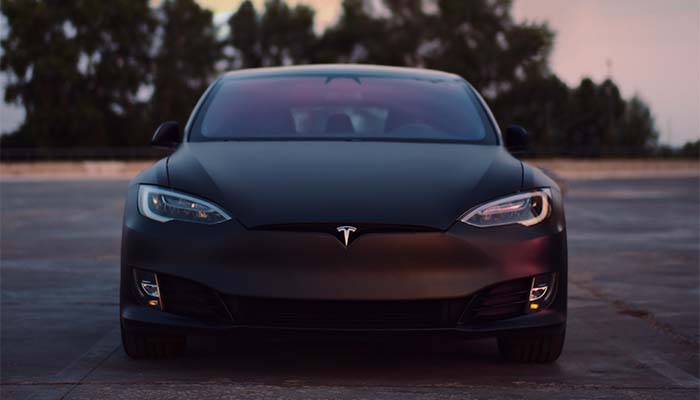
Updated April 3, 2022
Many people hesitate to purchase an electric vehicle because they’re worried about range. You know about the environmental benefits and the cost savings, but that doesn’t do you much good if your EV lacks the range to get from A to B. So, how long does a Tesla battery last?
A Tesla battery will last for a minimum of 267 miles per charge. However, several Tesla models have longer-range ratings. Tesla batteries are also rated to work for up to 35 years.
Let’s talk about more of the specifics, including some variables that could impact your mileage.
Tesla Mileage After One Charge
The minimum range for any Tesla car is 267 miles per charge. But just like a gas engine, a lot of this depends on how you drive. The harder you press the accelerator and the more aggressively you drive, the faster you’ll drain your battery.
Unlike gas vehicles, Teslas actually have a higher city range than highway range. That’s because their brakes actually generate battery power. Since you brake more in the city, you get slightly higher range.Furthermore, different Tesla models have different ranges per charge. Here’s a quick look at the ranges for the Model 3, Model S, Model X, and Model Y, along with their sub-variants:
| Model: | Combined city/highway: |
| Model 3 | 267 miles |
| Model 3 Long Range | 334 miles |
| Model 3 Performance | 315 miles |
| Model S | 375 miles |
| Model S Long Range | 405 miles |
| Model S Plaid | 348 miles |
| Model X | 332 miles |
| Model X Plaid | 313 miles |
| Model Y Long Range | 318 miles |
| Model Y Performance | 303 miles |
Let’s say you have a 60-mile commute, and you drive a basic Model 3. You’ll be able to drive to and from work for two days, and charge up afterward. You’ll even have a few extra miles left over for errands. And that’s just the base model. Depending on which Tesla you own, you can get up to 405 miles per charge.
This makes it feasible to take a cross-country road trip. 405 miles is a long way, and you’re going to want to get out and stretch your legs and have something to eat. If you plan your trip ahead of time to take account of Supercharger locations, you’ll have no more trouble traveling than you would with a gas vehicle.
What Factors Will Affect My Mileage?
There are a number of factors that can impact your Tesla’s mileage. The vehicle model, battery capacity, and your own driving habits will all come into play. Here’s a closer look at each of those factors.
Vehicle Model
The Model 3 is designed to be a basic commuter option. It’s made for running errands, or dropping your kids off at soccer practice, at a more reasonable price than other Tesla models. Even so, Tesla has made improvements with almost every model year. For example, the 2020 Model 3 had a range of 253 miles, while the 2021 version had a range of 263, and the 2022 version has been extended to 267 miles.
The Model S is Tesla’s performance model and can go from 0 to 60 miles per hour in only 3.1 seconds. It also has a slightly longer range than the Model 3. But if you want to get the maximum possible range, you’ll want to opt for the Model S Long Range, which is outfitted with a more powerful battery.
Tesla’s Model X is their SUV, and as you might expect, it won’t go as far on a charge as the Model S. It still outperforms the Model 3, though.
One thing that’s worth noting is that the Model S and Model X Plaid actually have a shorter range than the respective base models. That’s because the Plaid models come with extra features, including improved traction control and faster acceleration. This burns through your batteries slightly faster.
Battery Capacity
The most important factor that determines your range is the capacity of the battery itself. The Model 3 has the shortest range, and it also has the smallest battery. Conversely, the main difference between the Model S and the Model S Long Range is that the Long Range has a bigger battery.Keep in mind that the battery is the most expensive part of a Tesla. As a result, longer-range Teslas tend to be more expensive. The Model 3 has an MSRP of just $44,990. By comparison, the Model S Long Range has a price tag of $94,490. The Model X Plaid is the most expensive at $126,490, but it’s an SUV, and it’s packed with luxury features.
Your Driving Habits
Just like with an ordinary gas car, your driving habits will also have an impact on your range. If you’re driving at very high speeds or doing a lot of hard accelerating, your battery won’t last as long.
Even if you’re driving carefully, road conditions can affect how long your battery lasts. If you’re driving in the snow, for example, the traction control will kick in more often, shortening your range.
The same goes for the condition of your car. Keep your tires inflated to the right pressure, avoid carrying unnecessary weight, and have all the recommended maintenance done on schedule.
How Long Until I Need a New Battery?
According to Elon Musk, Tesla’s batteries will last between 300,000 and 500,000 before they need to be replaced. That’s 1,500 battery cycles. The average driver drives 13,500 miles per year, so you’re looking at 22 to 37 years of use.
That said, the warranty only covers you for the first 100,000 to 150,000 miles, depending on the model. After that, you’ll be on the hook for any repairs or replacements.
As you drive more and more miles, your battery will slowly lose capacity. By the time you get to 300,000 or 500,000 miles, you won’t be getting anywhere near your original range. So, what would it cost to fix your battery?
Musk also says that a replacement battery module costs between $5,000 and $7,000. But a Tesla battery contains several modules, so replacing the entire pack could be expensive.
Tesla’s Battery Warranty
Because replacement Tesla batteries are expensive, it’s important to understand the terms of the warranty, which differ between models and model years. Here’s a quick overview.
| Model | Battery Life | Battery Miles | Remaining capacity |
| Model 3 | 8 years | 100,000 miles | 70% |
| Model 3 Performance/Long Range | 8 years | 120,000 miles | 70% |
| Model S (2012-2015) | 8 years | 125,000 miles | N/A |
| Model S (2016-2019) | 8 years | Unlimited | N/A |
| Model S (after 2020) | 8 years | 150,000 miles | 70% |
| Model X (before 2020) | 8 years | Unlimited | N/A |
| Model X (after 2020) | 8 years | 150,000 miles | 70% |
| Model Y | 8 years | 120,000 miles | 70% |
How Long Will Future Tesla Batteries Last?
Elon Musk says that Tesla is developing a battery that could last for a million miles. This battery is a special lithium-ion design that uses a unique combination of materials for the cathode and electrolyte. This Tesla-developed prototype can retain its capacity through 4,000 charge/discharge cycles.
Musk is well-known for setting overly-optimistic timetables, and it’s not clear when these new batteries will actually be introduced. We do know that they’ll be debuting in the Chinese market, so keep your eyes out for any announcement.
Conclusion
A Tesla battery will last for at least 267 miles per charge, and some models will last much longer. At a minimum, you’re warrantied for 8 years and 100,000 miles, and sometimes as many as 150,000 miles. With the potential for as many as 500,000 miles of use, you’re looking at some of the most advanced batteries on the planet.


